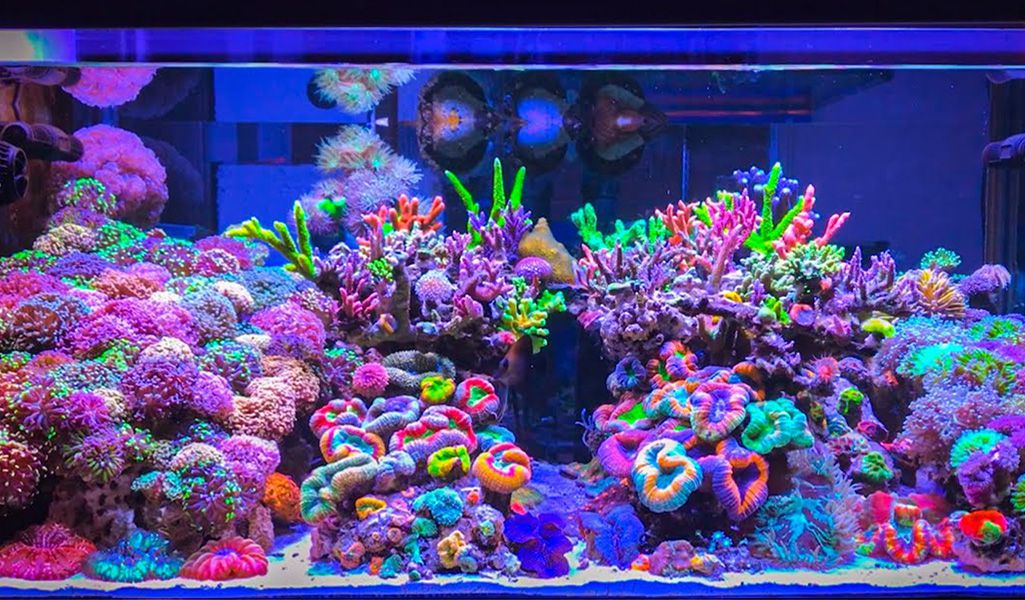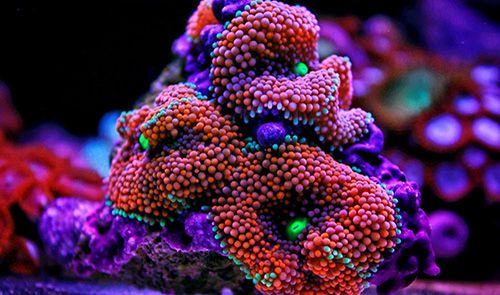Are you curious about saltwater reef aquariums? Live coral is the main character of the reef aquariums, which makes the tank more appealing. Also, the coral reef provides hiding places for fish. In this article, we will talk more about corals. After reading, you can get a deeper understanding of corals, like coral types and reef tank coral maintenance.
Content Table
Where does the reef tank live coral come from
Statistics report that there are about 6000 coral species in the world. But do all corals in reef tanks are natural corals? Actually, no. Catching corals in the wild is not environment-friendly. Wild corals are usually caught from the reef. On the other side, there are cultured corals, including corals grown artificially in the ocean and house. Depending on the corals’ growing techniques, humans can harvest the corals regularly. Even some corals are more brilliant than those that grow in the wild. Most corals in reef tanks are captive propagated corals.
Coral profile
Generally, corals include hard corals and soft corals. Hard corals, also named scleractinia and stony corals, always grow in colonies and live inside zooxanthellae. Hard corals comprise LPS corals (large polyp stony corals) and SPS corals (small polyp stony corals). As for soft corals, they are soft and bendable, such as Mushroom corals, Zoanthids, and Kenya tree corals. Also, they fancy living in colonies. But soft corals do not have stony skeletons, accordingly, they can not build the coral reef.
Both hard and soft corals can be kept in reef tanks. However, how can they survive in reef tanks? Most corals are photosynthetic organisms and need proper aquarium light, water conditions, water flow, and diet. Next, we will share some coral maintenance tips.

- Aquarium light & Water flow
The light and water flow requirements vary in different corals types. Also, the light and water flow requirements would determine which corals you should choose and where you should place them in reef tanks. For instance, if you have a tank with intense light and strong water flow, adding hard corals to your tank is feasible.
In the table below, we will list the common light and water flow requirements for varying coral types.
Tips:
- PAR: Photosynthetic Active Radiation (a unit of light intensity measurement)
- LPH: Liters Per Hour (a unit of flow rate measurement)
| Light requirement | Water flow requirement | |
| Soft corals | Low light (50-150 PAR) | Low water flow (20 times turn over per hour) |
| LPS corals (Hard corals) | Low to medium light (50-150 PAR) | Medium water flow (20 times turn over per hour) |
| SPS corals (Hard corals) | Highlight (200-300 PAR) | High water flow (50 times turn over per hour) |
For example, if you have a 250-liter reef aquarium with soft corals, it needs an aquarium light of 50-150 PAR. It requires a water flow of 5000 LHP.
Water condition
Corals are sensitive to water conditions. Consequently, water parameter fluctuation is damaging to corals. As a result, it is vital to monitor the water condition regularly. Also, adding live nitrifying bacteria (aerobic bacteria) and anaerobic bacteria in the water is beneficial to keep the water clean. The aerobic bacteria can transform feces and uneaten food into nitrate. The nitrate can be converted into nitrogen by the anaerobic bacteria.
Ideal water condition for corals in tanks:
- Water temperature: 73-84℉ (23-29℃)
- pH level: 8.2-8.5
- Ammonia level: 0 ppm
- Nitrite level: 0 ppm
- Nitrate level: less than 10 ppm
- Diet
Most corals can gain adequate food from lighting, like zooxanthellate corals. Nonetheless, some corals need manual feeding. Generally, plankton, frozen coral food, dry coral food, and liquid food are available food sources for corals. Plankton includes phytoplankton (e.g. diatoms) and zooplankton (e.g. brine shrimp). Most frozen coral foods are meaty ones, like Brine shrimp and Mysis shrimp. Take SPS corals as an example, they can get nutrients from intense light. However, adding amino acids is helpful for tissue growth and then enhances their colors. Besides that, it is best to reduce water movement when feeding the corals. Then corals can catch the food easier.
Easy types of corals for a reef tank
Compared with soft corals, hard corals are more challenging to care for. Hence, soft corals would be a better choice if you are a beginner. In this segment, we will cover some corals that are easy to keep and suitable for reef tanks—for instance, Zoanthids, Mushroom corals, and Green star polyps.
Zoanthids (Soft corals)
Featuring various brilliant colors, Zoanthids grow fast and can adapt to various light levels and water conditions. Also, a mat of tissue connects all the polyps. However, zoanthids may contain a neurotoxin, called palytoxin. Thus, you should be cautious to avoid palytoxin poisoning.
|
Size |
less than 1.5 inches |
 |
|
Light requirement |
Low light/8-10 hours per day |
|
|
Water flow requirement |
medium |
|
|
Placement in an aquarium |
bottom-top |
Mushroom corals (Soft corals)
Mushroom corals, also named Mushroom anemones, are hardy and grow fast. And they can reproduce even under low light. Moreover, mushroom corals always come in red, blue, green, purple, and gray colors.
|
Size |
0.5-2 inches |
 |
|
Light requirement |
low light/8-10 hours per day |
|
|
Water flow requirement |
low-medium |
|
|
Placement in an aquarium |
bottom-middle |
Green star polyps (Soft corals)
Green star polyps grow extremely fast and can cover rocks, corals, aquarium glass, and other surfaces. Nevertheless, it is best to trim them regularly. Otherwise, green star polyps would fill up your reef tank.
|
Size |
0.2-1 inch |
 |
|
Light requirement |
low-medium light/8-10 hours per day |
|
|
Water flow requirement |
medium-high |
|
|
Placement in an aquarium |
anywhere in the tank |
Bubble corals (Hard corals – LPS corals)
With white, purple, pink, and green shades, bubble corals are easy to care for. Nonetheless, they are fragile and may be damaged by strong water flow. Also, it is better to place the bubble corals into the substrate, which would be helpful to anchor them.
|
Size |
1–4 inches |
 |
|
Light requirement |
medium light/9-12 hours per day |
|
|
Water flow requirement |
low-medium |
|
|
Placement in an aquarium |
bottom-middle |
Sum up
Among hard corals, SPS corals are the most difficult to care for, then the LPS corals. When choosing corals for your reef tanks, you should consider the light and water flow of your tank, as well as the corals’ color. Bright corals would be a better alternative. By now, have you gained more ideas about corals for your saltwater tanks? Or if you have set up one, welcome to share in the comment. We are always happy to receive your sharing. Finally, thanks for your reading.


Leave a comment